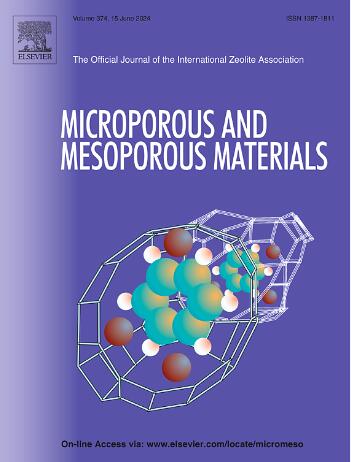Mesoporous planar TS-1 supported molybdenum catalyst for green epoxidation of olefins: Synthesis, characterization and catalytic properties
IF 4.8
3区 材料科学
Q1 CHEMISTRY, APPLIED
引用次数: 0
Abstract
Catalytic epoxidation limitations of conventional ellipsoid titanosilicate-1 (TS-1) remains owing to the narrow microporous channels and low efficiency of the Ti species. Herein, two-dimensional planer TS-1 zeolite (TS-1-P) was synthesized by adding crystal growth regulator in the hydrothermal synthesis process, and then TS-1-P supported molybdenum (Mo/TS-1-P) and mesoporous Mo/TS-1-P (Mo/MTS-1-P) were prepared and applied in epoxidation of olefins. The TS-1-P and the modified TS-1-P catalysts show a similar MFI framework and grain morphology but the different pore structure and coordination environment of Ti or Mo species. Especially, the Mo/MTS-1-P possesses many mesoporous pore and highly dispersed Mo species, which can improve the coordination environment of Ti species and weaken the Ti-O bond, the results are beneficial for the framework Ti species to combine more easily with H2O2 to C=C band of the olefin molecules. Therefore, compared with TS-1-P, Mo/MTS-1-P exhibits the highest conversion of ACH (91.78 %) and 1-hexene (47.44 %) in the epoxidation of ACH and 1-hexene, respectively, the selectivity of epoxidized products simultaneous is above 96.42 % and 94.04 %, respectively. Moreover, the deactivation behavior of carbon deposit on the catalyst surface and regeneration method were also proposed. The successful preparation of Mo/MTS-1-P not only results in an efficient catalyst for epoxidation process but also provides a possible approach for surface and pore structure modification of TS-1 zeolite.

求助全文
约1分钟内获得全文
求助全文
来源期刊

Microporous and Mesoporous Materials
化学-材料科学:综合
CiteScore
10.70
自引率
5.80%
发文量
649
审稿时长
26 days
期刊介绍:
Microporous and Mesoporous Materials covers novel and significant aspects of porous solids classified as either microporous (pore size up to 2 nm) or mesoporous (pore size 2 to 50 nm). The porosity should have a specific impact on the material properties or application. Typical examples are zeolites and zeolite-like materials, pillared materials, clathrasils and clathrates, carbon molecular sieves, ordered mesoporous materials, organic/inorganic porous hybrid materials, or porous metal oxides. Both natural and synthetic porous materials are within the scope of the journal.
Topics which are particularly of interest include:
All aspects of natural microporous and mesoporous solids
The synthesis of crystalline or amorphous porous materials
The physico-chemical characterization of microporous and mesoporous solids, especially spectroscopic and microscopic
The modification of microporous and mesoporous solids, for example by ion exchange or solid-state reactions
All topics related to diffusion of mobile species in the pores of microporous and mesoporous materials
Adsorption (and other separation techniques) using microporous or mesoporous adsorbents
Catalysis by microporous and mesoporous materials
Host/guest interactions
Theoretical chemistry and modelling of host/guest interactions
All topics related to the application of microporous and mesoporous materials in industrial catalysis, separation technology, environmental protection, electrochemistry, membranes, sensors, optical devices, etc.
文献相关原料
公司名称
产品信息
麦克林
ammonium molybdate
阿拉丁
1-hexene (1-H)
阿拉丁
allyl chloride (ACH)
阿拉丁
L-Carnitine
 求助内容:
求助内容: 应助结果提醒方式:
应助结果提醒方式:


